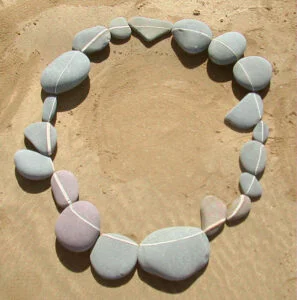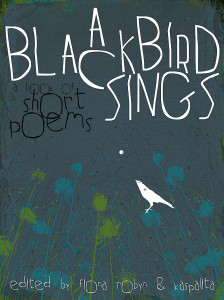For today's Writing Craft strand, novelist Satya Robyn explains the meaning, process and value of writing “small stones” – tiny observational pieces of poetry or prose detailing something close at hand.
This morning, I woke up grumpy.
I was too tired to clear up last night, and so was met with chaos in the living room and the kitchen. I burnt my wrist on the kettle. The cats meowed impatiently for their breakfast and I considered going back to bed.
And then, I noticed a red geranium petal on the dirty kitchen worktop.
I picked it up, and wrote a small stone about it:
Amongst the scattered crumbs, this fig-shaped geranium leaf. White-tipped and veined, it glistens in the light as if rubbed with powdered glitter. It is red, red.
This writing didn’t take long, but it took me away from the grumpiness and the crumb–scattered kitchen into a different mood. One of awe. One of gratitude.
What is a small stone?
A small stone is a short piece of observational writing – from one to a few sentences. It doesn’t have a strict form like haiku, and it can be in poetry or prose. The main purpose of writing small stones is that it encourages us to slow down and really notice what is around us – what we can smell, see, touch, hear, taste. I’ve been writing one every day (with a recent hiatus as I finished my fifth novel) since 2005.
People who write small stones have told me about all kinds of benefits from having a regular small stone practice. Writing small stones helps us to step outside our whirling head, which preoccupies most of us for most of the time. It is a discipline to notice at least one thing outside of ourselves every day. If we can be open to what is ‘other’, it can offer us new wisdom and remind us of how many options there are.
Paying attention helps us to notice what we already have – how much beauty there is around us. It encourages us to pause before the sunset or the bright splash of orange on our favourite mug. It is a pathway to gratitude.
Opening ourselves up to the difficult things (the slimy compost heap, the desiccated frog on the road) can point us towards work that needs to be done, and makes us less likely to shut down to those parts of our selves that contain suffering or ugliness. It encourages us to learn more about these parts of ourselves and others – to make space for them.
Writing daily small stones can also get us into good habits, and it is always helpful to practise good habits. We can begin to rely on the appearance of small stones, when we open ourselves up to them. They are all around us.
Small stones hone the writer's skills
For us writers, small stones keep our observational skills as sharp as a razor. It reminds us to look at the world with fresh eyes, which we need to do whether we are writing about facts or fiction. It also gives us practice at playing with words – at the craftsmanship that goes into each sentence.
I don’t need to convince you. Buy yourself a gorgeous notebook. Try writing one every day for a week, and see what you think.
On the 1st of November, people from all over the world will be writing a small stone as a part of our Mindful Writing Day. Join them?
Find out more about writing small stones, and submit your small stones to my blogzine ‘a handful of stones’ here.
today
four thrush eggs
in yesterday’s empty nest
~ Margaret Beverland
A misty morning over the moors, sheep drifting as day lifts ever so softly.
~ Máire Morrissey-Cummins
concertinaed traffic
a murmaration of starlings
shape the wet dusk
~ Matt Morden
walking the river upstream knee-deep in sun a moonscape in deep woods among deer prints in bank sand such neatly broken hearts
~ Peter Newton








[…] a poetry class on campus. Once a month, she leads participants in observational writing known as “small stones.” Similar to a haiku in length, but less structured, this approach in writing encourages the use […]
[…] a poetry class on campus. Once a month, she leads participants in observational writing known as “small stones.” Similar to a haiku in length, but less structured, this approach in writing encourages the use […]
[…] How Writing “Small Stones” Hones the Writer’s Craft […]
[…] How Writing “Small Stones” Hones the Writer’s Craft […]
[…] selfpublishingadvice.org […]
[…] readers of this blog recently enjoyed Satya Robyn's recent guest post about writing "small stones". Today we turn the focus on Satya herself – psychotherapist, Buddhist […]
Nifty. Reminds me of yoga – of being present in the moment. What better way than to write a stone?
Great advice – I love the Zen-like simplicity of it. I shall be buying another little notebook in the morning.
Because I like the discipline of form (otherwise I do witter on!), I tend to do them as haiku, the easy-peasy 3.7.3 version that kids get taught at elementary school. Here’s this morning’s: “Bamboo leaf/after rain. Tears quivering/in the wind.” Thanks for sharing /Small Stones/ with us here, Satya, and for reminding us of Mindful Writing Day.
Hello Orna – was just thinking about you. Lovely bittersweet haiku. Hope all’s good, sending love.
I really enjoyed this piece, Satya.
I suppose I have been writing “small stones” almost every day for 20+ years, but never knew they had a name!
They may be small words, yet they are words that touch the soul. Small stones reap big rewards.
Hi Penelope – yes, there is such good stuff in the detail…big rewards indeed!
This is lovely. I’ve never seen it given a name before, but I do it. I have notebooks filled with them. Off to tweet.
Ecellent advice. I hadn’t thought of this process as “small stones” per se. I do have a notebook that I keep with small stones for possible use at some time in some future works. These spontaneous thoughts can be forgotten in the next instant. I keep a list of personal mantras to help me through the rough spots.
It’s good to gather these scraps which then get worked into something else, isn’t it Warren?
A wonderful idea … like a prompt, but it seems both more satisfying and less laborious. I’ll try it.
Yes, less laborious – it should feel freeing, but of course like all writing it isn’t always!
This lovely practice seems sure to blend observation and gratitude into art. Thanks for sharing.
You’ve got the idea Christine. But it also includes a getting closer to the uncomfortable aspects of life, which might not always include gratitude, especially to start with. There’s a kind of faith that it’s better to get to know all of life better than we do…
Glad you liked it Dylene. Hope you might write a small stone today, & do join us on the 1st!
Thank you for this lovely post and great concept. Just what I needed this morning.